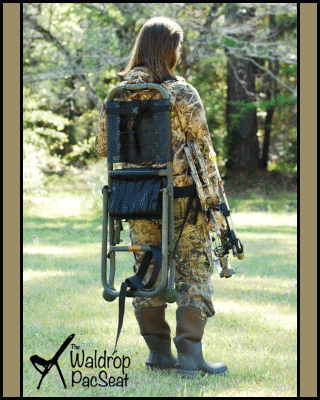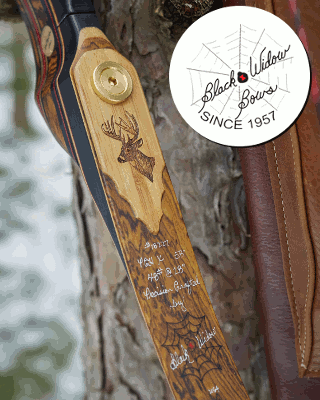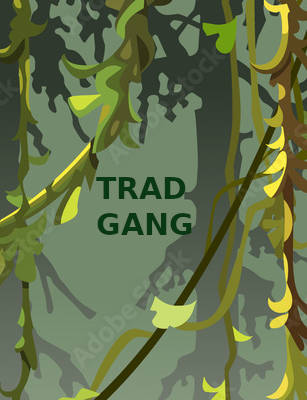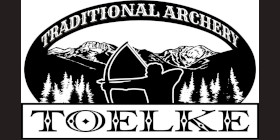YOUR FIRST WOODEN BOW
Following is a 50lb design that is easy and quick to make, is as fast and accurate as any, and costs about Six-dollars.
This bow is about the same length you are tall. Its drawn side-view shape is that of an English-tillered bow. This design's grip is part of the working bow itself, making the bow easy to layout and easy to make. It stores more energy than shorter bows, draws with less stack, and is more stable/accurate. It may have a larger number of good features than any other design. These instructions call for a lumberyard hardwood stave. With such a stave it's possible to read this in the morning and be shooting your bow the same afternoon. Not likely if you’re a beginner, but possible.
If you don't have access to such lumber do this: Cut a straight hardwood tree, split it down to four-inch wide wedges, take the bark off without damaging the wood surface. With saw or hatchet reduce the stave to your fingertip-to-fingertip arm span. Narrow the stave to 2.5” wide from end to end, 1" thick at the grip, 3/4" midlimb, and 5/8" at the nocks. Set it horizontally in the warmest, driest part of you house and wait a month. Let air move freely over all its surfaces, back and belly.
Selecting a lumber stave: Use any of the heavier hardwoods. Red or white oak, rock maple, hickory, pecan, mulberry, etc. Select a board on whose face its ring lines are almost perfectly straight, with no meanders, kinks, islands or bowlegs, and which are at least almost parallel with the board’s face. Don't bother about ring lines on the side of the board; they can be misleading; they don't need to run straight. You will likely have to look through 50 boards or more. Viewed from the butt end the ring can be flat to the board, angle through the board, or run vertically through the board.
Tools: A hatchet and a rasp are all that's absolutely needed. But a spokeshave and coarse and medium rasps make the work faster and easier. A block plane is helpful if used carefully. A bandsaw saves about two hours of roughing out.
Front-view layout: With a sharp pencil and a straight-edge draw the bow 1 3/8" wide from midlimb to midlimb. From there draw a straight taper to 1/2" nocks. Reduce the stave to these dimensions. Don't stray past the line. Create smooth square sides. Smooth out the angle where the midlimb begins to taper.
Side-view layout: Draw these lines on both sides of the stave: Let the center six-inches be 7/8" thick. Moving toward the nock, let the next two inches taper to 3/4" then to 9/16" at midlimb, then to 1/2" at the nocks. Let these thickness changes be smooth and gradual, with no angles.
Reduce the stave to those dimensions. Don't stray past the line. Remove the wood from one side of the belly at a time, with the tool at a slight angle, such that when both sides are done a slight crown will have been created along the center of the belly. Then remove most of the crown. It's important to do it this way. Otherwise at some point you will dip below the opposite line. This method also averages out any errors of reduction. It's also easier.
As you reduce down to the pencil lines frequently sight along the length of the limb from a low angle and make sure your work is smooth and uniform, with no dips or waves or dings. THIS IS THE MOST IMPORTANT PART OF BOWMAKING. This decides if your bow will break or not. If thickness taper is smooth and gradual it's difficult to break a bow.
Narrow the belly side of the grip just enough to cause a nocked arrow to rest square against it. Do this on both sides. Round all corners of the grip.
Cut nocks with a rattail rile or similar, then string the bow with a slack string. Set the center of the grip on one end of a 30" one-by-three board or similar, and place the string in a notch cut into that board, causing the bow to bend about five inches. Lean this rig against a wall then back up and inspect the curve of your new bow.
The shape you are seeking is not part of a circle, but the shape of a satellite dish antenna--an almost flat, only slightly bending grip, then each portion bending slightly more than the last as you move from grip to nocks, elliptical tiller. Don’t let the last ten inches or so bend any more than the area next to it.
It would be good to draw this shape on paper and have it ready to refer to while tillering.
If your bow does not take this shape, or if the limbs are not curving equally, make pencil marks on the belly where the limb is too stiff. Remove wood from these stiff areas only, first on one side of the belly then the other--then remove the slight crown created. Do this with long sweeping strokes, creating no dips, waves or dings, frequently sighting along your work, as above. THIS IS THE MOST IMPORTANT PART OF BOWMAKING.
When the curve finally suits you brace the bow about five-inches high and inspect it again. Mark any stiff portions and reduce them as above. When content with the curve draw the bow to half its intended draw weight, measured by you best guess or a scale. Set the bow on the tillering stick at this length of draw and mark any stiff areas in the limbs and remove as above. Re-check the tiller, re-mark, remove wood, etc. until perfect curvature is reached.
Now draw to full draw weight. If full weight is reached at, say, twelve of draw you need to remove a medium amount of wood along the bow's entire length. Do so by above methods, check for proper curve on you tillering stick, correct where needed.
Again draw to full weight, now at possibly fifteen-inches of draw. From this point on remove only paper-thin amounts of wood at a time. Pull to full draw weight after each curve check, setting the string in ever farther notches as draw length increases, but never farther than five inches short of intended draw length, and not even there for more than a few seconds.
Continue this process until about one-inch short of intended draw length. Smooth all surfaces to your taste, slightly round all corners, and you're done. The bow will settle right into its design weight. Nock the arrow just above the center of the grip.
The arrow will fly more accurately with one limb or the other as the top limb, but this may change over the life of the bow.
Please ask for details or clarification if needed.
Tim Baker




















